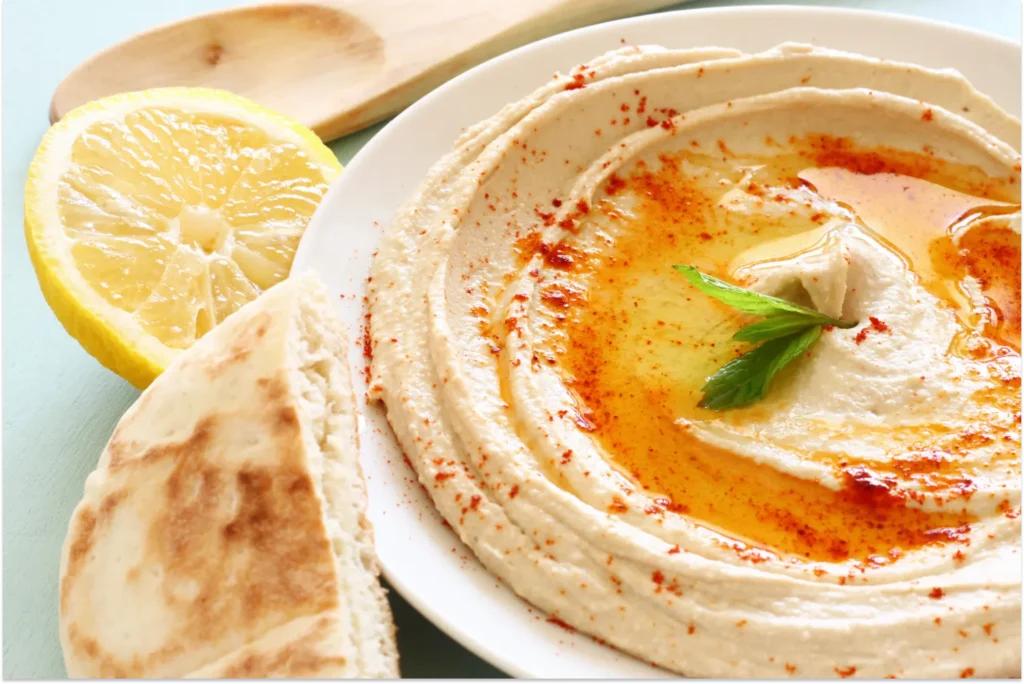If you embark on a culinary journey through the rich tapestry of the Mediterranean and Middle Eastern regions, hummus emerges as a beloved and timeless staple. When made at home, this creamy delight, derived from simple ingredients, contrasts sharply with the store-bought varieties often brimming with preservatives.
With the convenience of a trusty food processor and everyday ingredients from your local grocery store, creating an authentic hummus recipe is achievable and deeply rewarding.
What Is Hummus?
When we talk about hummus, we’re talking about a dish that is more than just a dip; it’s a tradition, a part of a heritage, and a culinary masterpiece in its own right. The main ingredients in hummus include garbanzo beans (often called canned chickpeas or dried chickpeas), creamy tahini, zesty lemon juice, aromatic garlic cloves, and a generous amount of extra virgin olive oil. These ingredients combine to form a smooth, velvety texture and an unforgettable taste.
Deep-rooted in the Mediterranean diet, hummus often finds its place as a delectable appetizer or a complementary side with dishes like falafel. It’s not just about the flavor but the experience — the act of dipping warm pita bread into a serving bowl of freshly made hummus, watching the drizzle of olive oil glisten, and sprinkling vibrant paprika and sesame seeds for that added burst of color and taste.
Is Hummus Good for You?
Hummus is a nutritional powerhouse, more than just a delightful dip or spread. Originating from the rich culinary traditions of the Mediterranean and Middle Eastern regions, it has, over time, garnered global appreciation not just for its taste but also for its health benefits.
At the core of hummus are garbanzo beans (chickpeas), which are rich in dietary fiber. This aids digestion and can help maintain a healthy gut.
Additionally, hummus is a good source of potassium, essential for heart health, and vitamin C, which supports our immune system. Vitamin A, found in hummus, maintains good vision and skin health. Its calcium content supports bone health, making it beneficial for individuals of all age groups.
Moreover, hummus is a great option for those with specific dietary requirements. It’s naturally gluten-free, catering to those with gluten sensitivities or celiac disease. It’s also low in cholesterol, supporting heart health and offering a guilt-free indulgence.
In a world teeming with processed foods, hummus stands out as a wholesome option. Whether you’re looking for a healthy appetizer, a post-workout snack, or just a flavorful treat, hummus is a versatile choice that marries nutrition with taste.
How To Make Hummus: Step-by-Step Guide
Embarking on the hummus-making journey, one quickly realizes that it’s not just about mixing ingredients; it’s an art form, a delicate balance. As with any art, the key to perfection lies in preparation.
Understanding the prep time and total time is crucial before diving into the heart of our easy hummus recipe. If you’re using canned chickpeas, this process can be swift, turning homemade hummus into a quick endeavor. However, if dried chickpeas are your choice, factor in the additional soaking and cooking time.
On average, preparing the ingredients can take about 15 minutes, while achieving that desired consistency and smooth hummus blend in a food processor might take another 10 minutes. While this might seem a little time-consuming, remember the best hummus recipe is made with love and patience.
It’s important to have a good food processor to achieve the best hummus texture. This mighty tool is the secret to transforming your drained chickpeas, tahini, and other ingredients into a creamy hummus that rivals any middle eastern restaurant’s offering. While you might find recipes suggesting blenders or immersion sticks, the food processor ensures the smoothest texture.
The blades puree the chickpeas and blend them seamlessly with tahini, fresh lemon juice, garlic cloves, and other additions. Investing in a good-quality food processor is a game-changer for that unparalleled creamy hummus texture. Remember, while ingredients form the base of the hummus, it’s the equipment that gives it that unforgettable texture.
Ingredients for Authentic Hummus
The heart and soul of any hummus recipe lie in its ingredients, those wholesome elements that come together to form the rich, creamy texture and the unmistakable Mediterranean flavor profile we all adore.
For authentic hummus, you’ll need:
- Garbanzo Beans (Chickpeas), one can: Whether you choose canned chickpeas for convenience or dried chickpeas for a more traditional approach, they form the primary base. For best results, ensure they are well-drained. If your chickpeas are not peeled, make sure to peel them before blending them in the food processor.
- Tahini, ¼ cup: This rich, nutty sesame seed paste lends depth and creaminess to your hummus.
- Fresh Lemon Juice, 2 Tbsp: Adds zest and a citrusy tang.
- Garlic Cloves: Introducing that subtle sharpness, always go for fresh garlic for the best flavor.
- Extra Virgin Olive Oil, 2 Tbsp: For a silky finish and rich flavor.
- Ground Cumin, pinch: For a hint of warm, earthy tones.
- Sea Salt or Kosher Salt, ½ tsp: To enhance and balance the flavors.
- Cold Water: Helps achieve the perfect, smooth consistency.
For those looking to experiment, roasted garlic or red pepper can offer variations, while additions like sumac, pine nuts, fresh parsley, or cilantro can provide a unique twist to the traditional flavor.
To make hummus at home, place all these ingredients except water in a food processor. Blend all ingredients on high until the mixture becomes creamy, adding water if the consistency is too thick.
How To Serve Hummus
Presentation plays a pivotal role in the culinary experience. Once you’ve achieved that velvety, smooth hummus, it’s time to serve it with flair. Begin by transferring your homemade hummus into a serving bowl, spreading it with the back of a spoon to form a shallow well in the center.
Now, for the garnish. Drizzle a generous amount of extra virgin olive oil on your hummus, ensuring it pools slightly in the well.
Sprinkle a dash of paprika for a hint of color and spice, followed by sesame seeds that add a delightful crunch. Fresh parsley or cilantro can be chopped and strewn on top for a burst of freshness and color.
When it comes to accompaniments, nothing beats warm pita bread cut into triangles and slightly toasted. Alternatively, pita chips offer a crisp bite. For those looking for a healthier option, an array of fresh veggies like carrots, bell peppers, and cucumbers make perfect dippers. Whether it’s a casual snack or a sophisticated appetizer, serving your hummus with love and attention to detail elevates the entire experience.
Tips and Tricks for the Best Hummus Recipe
Crafting the perfect hummus requires a blend of traditional techniques and personal flair. Here are some insider tips to elevate your hummus game:
- Canned vs. Dried Chickpeas: Canned chickpeas are convenient, but dried chickpeas, when soaked overnight with a pinch of baking soda, result in a smoother texture. Baking soda softens the chickpeas, ensuring a creamier hummus.
- Fresh Ingredients: Always opt for fresh lemon juice and garlic. The vibrancy of fresh ingredients intensifies the flavor, making a noticeable difference.
- Taste as You Go: The balance of tahini, lemon juice, garlic cloves, and salt is subjective. Adjust these ingredients little by little, tasting as you go until it’s just right for you.
- Spice It Up: For a kick, consider a dash of cayenne or red pepper. It adds a gentle heat that lingers on the palate.
- Storage: Preserve the freshness of your homemade hummus by storing it in an airtight container in the refrigerator. This helps maintain its creamy consistency and rich flavor. Your homemade hummus can last for up to three days in the refrigerator.
Our Recipe
Here’s a simplified version of our hummus recipe that will make about two cups:
| AMOUNT | INGREDIENTS | NOTES |
| 1 can | Garbanzo Beans | 1 – 15 oz can, drained and rinsed |
| ¼ cup | Tahini | |
| 2 Tbsp | Olive Oil | |
| 2 Tbsp | Lemon Juice | |
| 1 ea. | Garlic clove | |
| ½ tsp | Salt | |
| Water | If needed to decrease thickness |
Summarized Instructions:
- Place all ingredients in a blender or food processor, except water.
- Blend on high until creamy.
- Add water if it is too thick.
- Place in an airtight container and refrigerate.
- Can be kept in the refrigerator for up to three days.
Wrapping Things Up
Congratulations! You’ve unlocked the secrets to crafting an authentic, mouth-watering hummus recipe that’s sure to impress. As you savor the taste of your homemade hummus, remember the journey of flavors doesn’t end here.
We encourage you to share your hummus masterpieces, experiment with variations, and immerse yourself further in different Mediterranean culinary delights. Remember that homemade hummus is a show-stopping appetizer, so the next time you host a dinner party, use this recipe to wow your friends and family.
Furthermore, Luna Grill beckons those who hold authenticity and quality close to their hearts. Discover our commitment to sourcing the finest ingredients and offering a plethora of authentic Mediterranean options you can try alongside your homemade hummus.
Dive deeper, explore, and let your palate be your guide. Enjoy the journey!
Sources:
Dietary fiber: Essential for a healthy diet | Mayo Clinic
Potassium | The Nutrition Source | Harvard T.H. Chan School of Public Health
Calcium and calcium supplements: Achieving the right balance | Mayo Clinic



